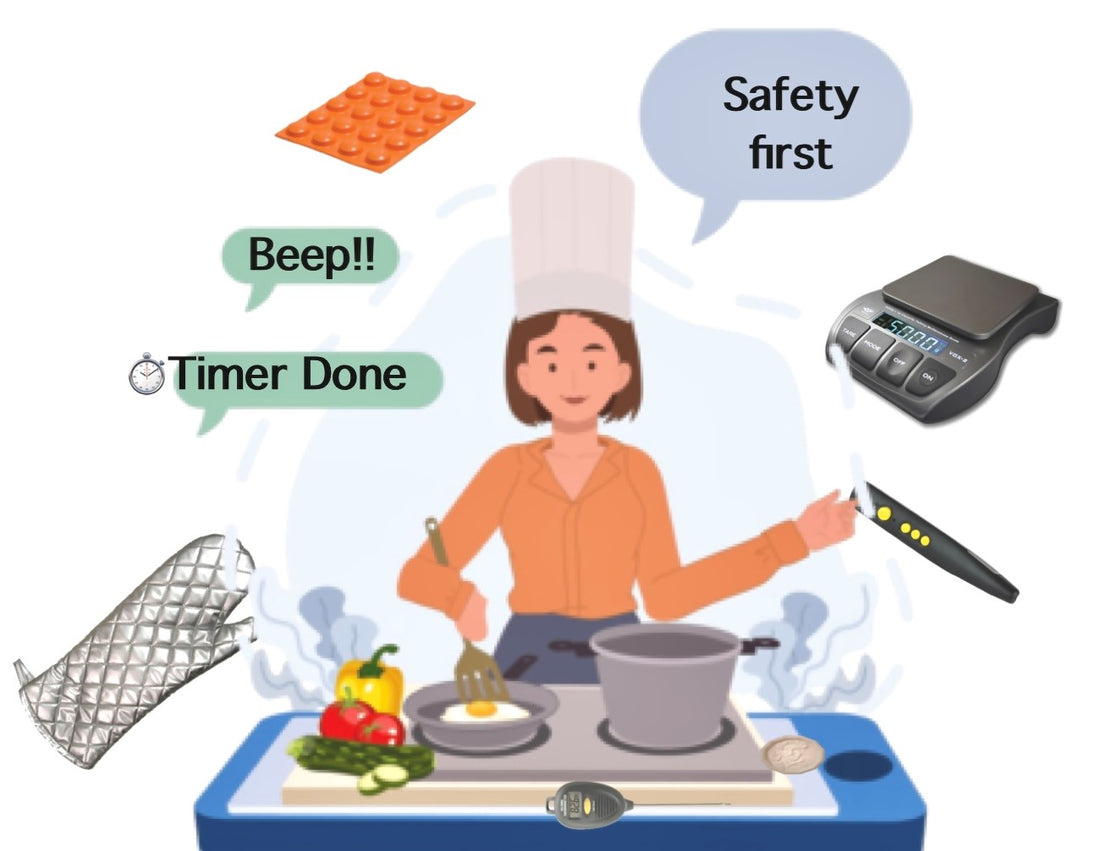
Thanksgiving Kitchen Safety And Accessibility
Thanksgiving Kitchen Safety And Accessibility
"Feast without Fears, Cook with Cheers: Thanksgiving Safety First!"
The kitchen can be a delightful place filled with the aromas of freshly cooked meals and the joy of preparing that perfect meal. However, for individuals with blindness or low vision, the kitchen can also pose unique and potential challenges regarding safety. In this blog, we will explore essential kitchen safety tips tailored to those with visual impairments and recommend a few products that are designed to make your kitchen a safer and more accessible space this Thanksgiving and beyond.
Organize Your Kitchen
The first step in ensuring kitchen safety is to organize your kitchen space. Consider the following tips:
Group similar items:
Store pots, pans, and cooking utensils in the same areas. Keep items in designated areas by developing a system for arranging items in your fridge and pantry so you can find what you need when you need it easily.
Place cutlery and small kitchen tools in a designated drawer for easy access. Knife safety is crucial for all cooks, and it's essential for those with limited vision. Try to purchase knives that come with sleeves to fit over the sharp blade so that you are not reaching into an unsafe drawer. Knives with knife guards for cutting are a must-have when preparing any meal for your family and for your safety.
Three o’clock - Nine o’clock: No, this is not to remind you when you have to punch in to work or remind you to turn on your favorite wrestling TV show on Monday night. This is about turning the handles of your pans and skillets in the direction of three and nine o’clock so that you do not accidentally bump into the hot pots and pans spilling your delicious meals on yourself and the floor. Turning your handles outward of your stove can help minimize accidents. Place easily tipped items, oven mitts, and tows away from hot surfaces to prevent accidental fires.
A true sticking point - Tactile labels: use devices like the WayAround Starter Pack for labeling and tagging your items and an app that works with most smartphones or the PenFriend III Voice Labeling System to label all your groceries, canned goods, spices, and practically anything imaginable that you can put a label on. You can also achieve this by using a Braille Labeler.
Another option would be to use bump-dots with high-contrast colors on your stovetop or microwave so that setting the correct temperature becomes a breeze. You can place them on most stoves, microwaves, and refrigerators.
Adapt Your Cooking Techniques
Adapting your cooking techniques can help mitigate potential safety hazards:
Spoken Like A True Chef - Talking Technology to the Rescue: Talking Countdown Kitchen Timers, and Talking Cooking Thermometers can be helpful tools when cooking. Large buttons and clear voice prompts can help with precise timing while cooking. No more guessing how long you’ve been cooking that turkey or how much time is left. You can even use your smart device for this as well. Just ask Alexa, Siri, or Google and they can do it for you. Consider adding a Talking Kitchen Scale that can provide voice feedback while weighing your ingredients allowing adaptive devices to work for you. Additionally, Opt for safer cooking methods like baking, roasting, and using slow cookers to reduce the risk of burns and splatters. Place Single Cover Oven Guards on your oven racks to minimize the risk of burning your hands and always use Heat Resistant Oven Mitts to handle pots and pans.
Frequent handwashing: This one is a no-brainer but I wanted to list it to remind myself as well lol Wash your hands frequently, especially before handling food. Making handwashing a routine part of your daily activities is a proactive step in maintaining good hygiene and preventing the spread of infections.
Accessible Kitchen Appliances and Gadgets
Numerous kitchen appliances and gadgets are available with features tailored to individuals with visual impairments. Head on over to our store by clicking here to check out some of our latest kitchen items and bundles for a better and safer cooking and kitchen experience.
Conclusion
A safe and accessible kitchen is achievable with proper organization, adapted techniques, and the use of specialized products for people who are blind and visually impaired. By following these kitchen safety tips and utilizing accessible products, you can continue to enjoy the pleasures of cooking while minimizing potential hazards and ensuring a safer and more enjoyable culinary experience.
Happy Cooking!
